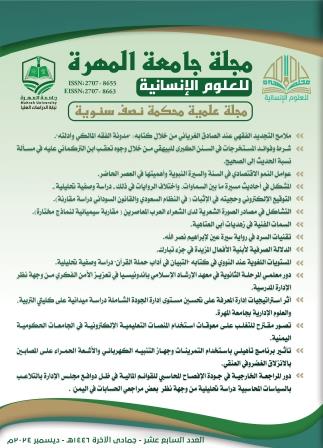The Linguistic Levels as Illustrated by Al-Nawawi in his book “Al-Tibyan in the Etiquette of the Bearers of the Qur’an” A Descriptive analytical study
DOI:
https://doi.org/10.71311/.v5i2.162Keywords:
Language, Al-Nawawi, Semantics, Grammar, DictionaryAbstract
The research, which is descriptive and analytical in nature, aims to explore Al-Nawawi’s linguistic levels in accordance with the style he followed when writing his book entitled “Etiquette of the Qur’an Bearers.” This research concentrated on studying Al-Nawawi’s use of the word, the sentence, and the verbal context devoid of texts quoted from the Holy Qur’an, the Noble Hadith, and the words of scholars. This research come up with some results, the most important of which are: the quality of choosing words and meanings appropriate to the target group. Hence, Al-Nawawi tended to combine both the declarative and constructive manner; as a desire to provide brief content to the recipient and benefiting him from an ethical perspective. Moreover, it provides the sources and derivatives according to their original meanings, as measured and free of abnormalities. An indication of Al-Nawawi’s linguistic prowess. In terms of its plurals, they were consistent with the context, in addition to the sufficient use of feminine plurals in order to depict exaggeration. The researchers also preferred to lengthen his sentence structures with the aim of clarifying the meaning. The phonetic level followed what was agreed upon among linguists regarding "hamzah" and "assimilation". As for the semantic level, it is rarely strange because it is directed to a specific category of beneficiaries.
Downloads

Downloads
Published
How to Cite
Issue
Section
License
Copyright and Licensing
copyright is retained by the authors. Articles are licensed under an open access Creative Commons CC BY 4.0 license, meaning that anyone may download and read the paper for free. In addition, the article may be reused and quoted provided that the original published version is cited. These conditions allow for maximum use and exposure of the work.

